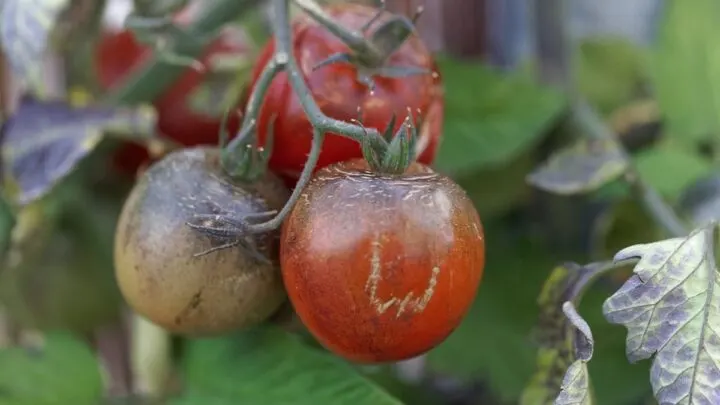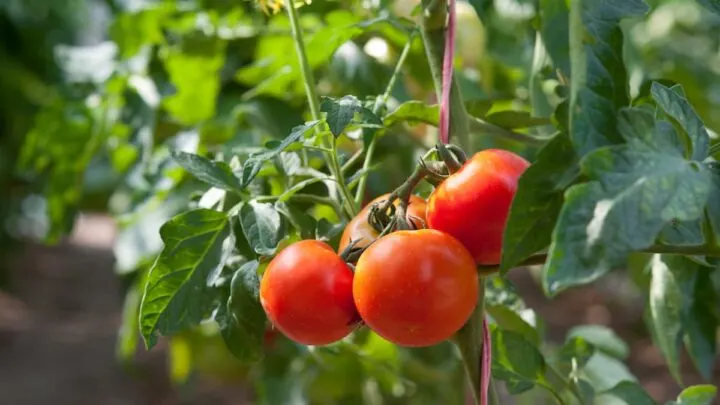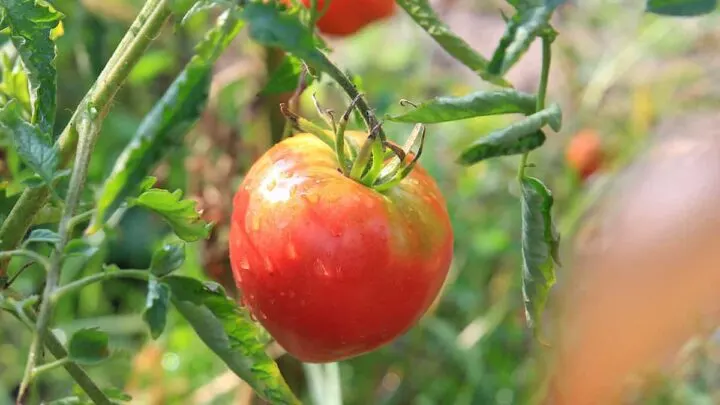Tomatoes are a fun, exciting vegetable to grow during summer. However easy, there are still some things that can go wrong, causing your tomatoes to taste like chemicals. You may be wondering, why do my tomatoes taste like chemicals?
Growing conditions, and the environment a tomato plant is in, can significantly affect the acidic and sugar levels in the tomatoes. When those levels are imbalanced, the tomatoes may taste like chemicals.
Below, we will discuss all the reasons why your tomatoes may taste like chemicals and if we can fix the issue. Keep reading.

7 Causes Of Off Flavors In Tomatoes
Variety
Not all tomatoes taste the same. This is an important thing to know when you are picking tomatoes to grow in your garden. When they are fully ripe, different tomatoes will have different amounts of sugars that affect their taste. Here are some examples.
| Variety of Tomato | Taste |
| Brandywine | Juicy, flavorful, less bitter |
| Purple Calabash | Complex flavor, more tart and citrusy |
| Cherry Tomatoes | Both sour, tart and sweet |
| Better Boy | Classic tomato flavor, perfectly sweet and sour |
| Cherokee | Rich, and sweet, have an earthy flavor |
All fully ripe tomatoes lie anywhere from 4-4.92 on the pH scale; the higher the pH, the lower the acidity level. Tomatoes like Brandywine tomatoes, and Better Boy tomatoes, have a higher pH, meaning they are less acidic. Their sugar levels are much higher, making them a sweeter-tasting tomato. Purple Calabash tomatoes are one of the lowest on the scale, meaning they are some of the most acidic tomatoes out there.
When you are choosing a variety of tomatoes, be sure to do some research on what the mature tomatoes’ pH is so you know if you are getting a sweeter tomato or a more bitter-tasting tomato.

Amount Of Sunlight And Location
Like all living things, the proper sunlight is crucial to a tomato plant’s growth and development. Without the right amount of sunlight, things like stunted growth, yellow leaves, underdeveloped fruit, and funny-tasting tomatoes will happen.
Tomato plants need full sunlight, around 6-8 hours of direct sunlight a day in a location under the direct sun, where they have enough room to grow. Tomatoes take the sunlight and convert it into energy, which eventually helps the process of photosynthesis. As you can see, if they don’t have the sunlight they need, they won’t be able to continue with the growing process.
Ripeness Of The Fruit
Often people think they’ve done something wrong in growing tomatoes, when in fact, all they’ve done is harvest the fruit too early or too late!
When a tomato is at its perfect level of ripeness, it will taste its best. If you pick a tomato too soon, all the sugars the fruit needs haven’t been able to get to the fruit yet, which would leave it tasting bitter. If you pick a tomato too late, too many sugars and other nutrients are being pushed into the fruit, which would also make the tomato taste off.
It can be challenging to learn when a tomato is at its perfect ripeness, especially if you have colorful heirloom tomatoes. The best way to tell a tomato is ready for harvest is to give the tomato a slight squeeze. It should feel perfectly soft, not too hard, and not too soft.

Water Levels During Growth
Water plays a massive role in the growth of tomatoes. Tomatoes are heavy water feeders and need around 2 inches of water per week to thrive and survive. When a tomato plant isn’t getting enough water, the nutrients can’t flow through the plant like they usually would be able to. This means that the nutrients can’t get to the fruit, which would make them taste not so good.
On the other hand, a tomato plant that gets too much water gets drowned and waterlogged. The nutrients get washed away in this case and, again, cannot flow properly through the roots and into the fruit.
Soil Phosphorus and Potassium
Aside from water, tomatoes also need a lot of nutrients during their growth. While they are in their growing stages, they need plenty of nitrogen, which helps them grow strong and stay green. Once they start to fruit, the nitrogen levels can be cut down, as you want the plant to focus on sending the sugars to the fruit.
This is where phosphorus comes in. Phosphorus transfers energy and converts sunlight and other nutrients into sugars and starches that are eventually sent to the fruiting tomato. Without a healthy amount of phosphorus running through the plant, it will have a hard time creating its sugars, leaving the fruit tasting bitter.
Increased Levels Of Nitrogen
Above, I briefly mentioned that nitrogen does play a vital role in the growth of tomato plants; however, I also mentioned that it’s important to cut back on the nitrogen once the plant starts flowering.
If the plant is getting too much nitrogen, especially in its fruiting stage, the plant won’t know to send energy to the fruit, and instead, the plant will keep growing upwards. You also risk the potential of nitrogen burn, which can harm the plant.

How The Tomato Was Stored Prior To Eating
Often, canned tomatoes that are store-bought will taste very bitter. This is because many commercial companies leave the skins on the tomatoes before mixing them in the sauce. Much of the bitter taste lies in the tannins of the skin.
How To Prevent Bitter Tasting Tomatoes (3 Steps)
It’s quite easy to ensure that your tomatoes never taste bitter. Just follow these three things!
Right Amount of Sunlight
Tomato plants need 6-8 hours of sunlight a day. Before planting your tomatoes, watch the parts of your yard or wherever you plan to plant your tomato plants. Make sure this area has direct sunlight and gets sunlight at least 6 hours a day.
Right Amount of Water
As I mentioned, tomatoes need 2 inches of water per week. However, it isn’t just as simple as that. To ensure your plants are getting enough water, it’s essential to keep an eye on them and look for the signs.
Every day, check your plant’s soil; if it is dry 2 inches down, water right away. If the top layer of soil is still moist, they don’t need water yet. The general rule of thumb is, water your tomatoes every other day. If it is extremely hot outside, you will need water daily to be safe.
Right Amount of Nutrients
Knowing when your plants need nutrients can be tricky. The best way to start is to plant your plants in fertilizer with a well-balanced, slow-releasing NPK. This way, you don’t have to worry about giving your plants extra nutrients for at least three weeks.
While your plant is growing, you can give your plant a liquid feed with an NPK of 15-5-5 once a week to keep up with the amount of nitrogen the plant needs. Once the plant begins to bear fruit, cut back on the nitrogen, and give your plant a feed with an NPK of 3-15-15.
Final Thoughts
Tomatoes that taste like chemicals often indicate something wrong with their environment or how they are being grown. It could be something as simple as changing your watering patterns or including some more phosphorus into your plant’s diet. Happy gardening!

Hi there, my name is Allie and welcome to my blog; GareningWithAllie!
Much of what you see written here is just our personal experiences with gardening. Along with the content I write here, there is also a unique collection of gardening topics covered by some of our close friends. I hope you find everything you read here to be helpful, informative, and something that can make your gardening journey the most lovely experience ever! With that said, Happy Gardening!
